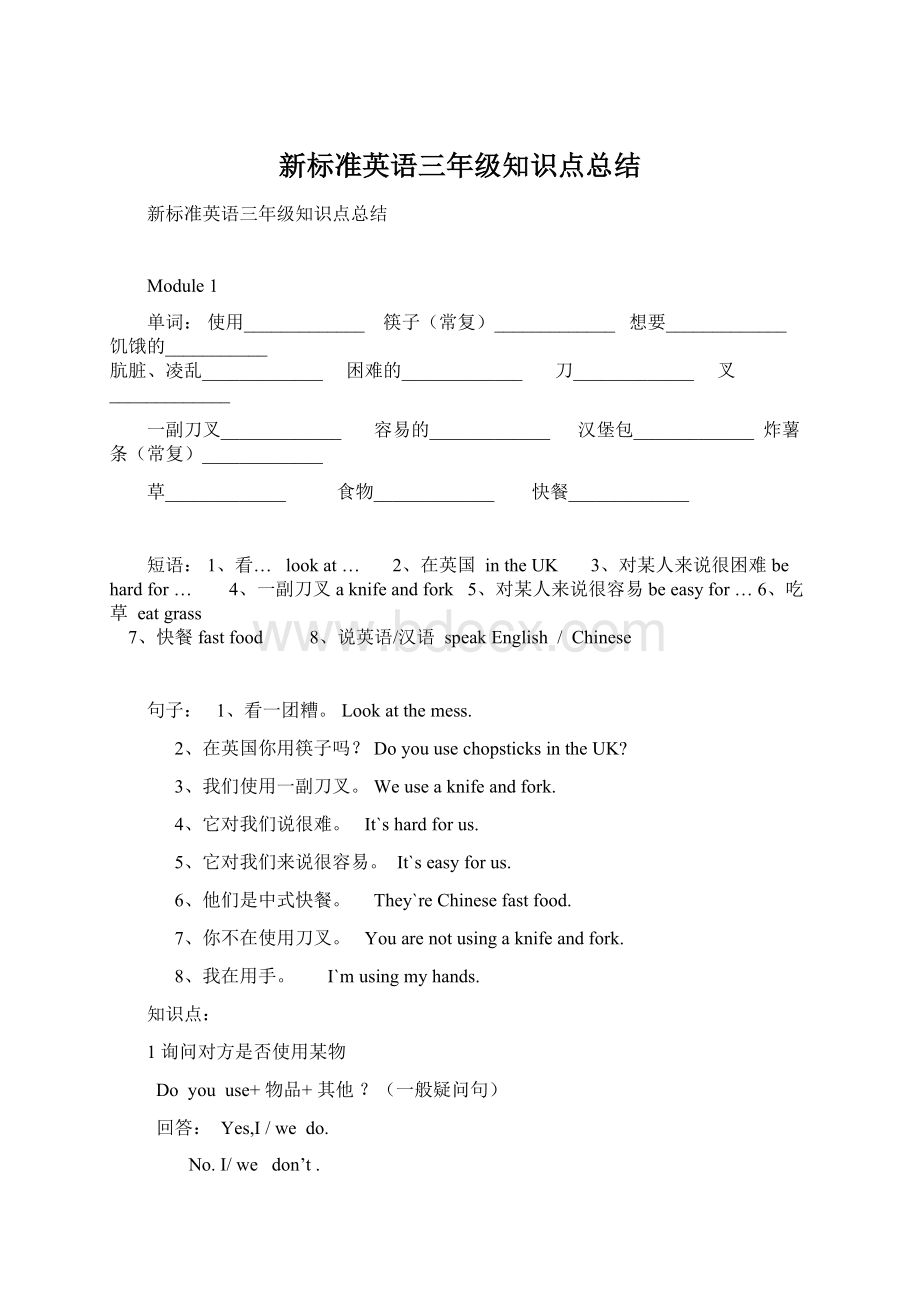 新标准英语三年级知识点总结.docx
新标准英语三年级知识点总结.docx
- 文档编号:7501027
- 上传时间:2023-01-24
- 格式:DOCX
- 页数:10
- 大小:20.97KB
新标准英语三年级知识点总结.docx
《新标准英语三年级知识点总结.docx》由会员分享,可在线阅读,更多相关《新标准英语三年级知识点总结.docx(10页珍藏版)》请在冰豆网上搜索。

新标准英语三年级知识点总结
新标准英语三年级知识点总结
Module1
单词:
使用_____________ 筷子(常复)_____________ 想要_____________ 饥饿的___________
肮脏、凌乱_____________ 困难的_____________ 刀_____________ 叉_____________
一副刀叉_____________ 容易的_____________ 汉堡包_____________ 炸薯条(常复)_____________
草_____________ 食物_____________ 快餐_____________
短语:
1、看… lookat … 2、在英国 intheUK 3、对某人来说很困难behardfor … 4、一副刀叉aknifeandfork 5、对某人来说很容易beeasyfor … 6、吃草 eatgrass
7、快餐fastfood 8、说英语/汉语 speakEnglish / Chinese
句子:
1、看一团糟。
Lookatthemess.
2、在英国你用筷子吗?
DoyouusechopsticksintheUK?
3、我们使用一副刀叉。
Weuseaknifeandfork.
4、它对我们说很难。
It`shardforus.
5、它对我们来说很容易。
It`s easyforus.
6、他们是中式快餐。
They`re Chinesefastfood.
7、你不在使用刀叉。
You arenot using aknifeandfork.
8、我在用手。
I`m using myhands.
知识点:
1询问对方是否使用某物
Do you use+ 物品+其他?
(一般疑问句)
回答:
Yes,I /we do.
No. I/we don’t.
2Do you want……?
Yes, please.
No, thank you.
3区分 What areyoueating?
和 Are you eating……?
句型
Module2
单词:
制作_____________ 蛋糕_____________ 妈妈_____________ 爸爸_____________安静的,不出声的_____________ 给(植物)浇水;水_____________ 可爱的_____________
短语:
1、安静bequiet 2、做蛋糕makeacake 3、去你的房间 gotoyourroom
4、看电视watchTV 5、吃蛋糕eatcakes 6、做作业 doone`shomework
7、好主意 goodidea 8.playthepiano弹钢琴 9.playthedrums敲鼓 10.watertheflowers浇花 11e来吃蛋糕
12Here youare给你 13Good idea好主意
14I’msorry很抱歉 15please stop请停止
句子:
1、你在做什么?
Whatareyoudoing?
2、我们正在做蛋糕。
We`remakingacake.
3、我在工作。
I`m working.
4、艾米在弹钢琴。
Amy `splayingthepiano.
5、萨姆在敲鼓。
Sam`s playingthedrums.
6、请安静。
Please bequiet.
7、我在浇花。
I`m watering theflowers.
知识点:
1 whatare youdoing?
回答 :
I’m …… 或者 We are ……
2现在进行时的基本句型结构
肯定句:
主语 +be +Ving+其他
例:
She is eating chips.
否定句:
主语 +benot+Ving+其他
例:
She isnoteating chips.
一般疑问句:
Be+主语+Ving+其他?
例:
Are you eating chips?
特殊疑问句:
疑问词+be+主语+Ving+其他?
例:
What are you eating?
新标准英语第3-4模块知识点总结
一单词:
动词:
row feed fly climb cry
名词:
boat peoplelake bread winner koala
形容词:
naughty paper fast slow
二短语:
underthe/flowers 在树/花下面
playhide-and-seek 玩做迷藏 paperflowers纸花
intherain 在雨中 dragonboat龙舟
onthislake在这个湖上 overthere在那边
watertheflowers浇花 lookat看
feedtheducks喂鸭子 ricenoodles米线
getout 走开 runfast跑的快
jumpfar跳得远 inthesky在空中
句子:
1Whatarethese/those?
They’re+事物名称(复数形式)
询问这些/那些是什么的句型,these用于指代近处的事物,those用于指代远处的事物
2this这个 对应词 that 那个
this的复数形式these
that的复数形式those
3Let’s row.咱们划船吧!
此句为祈使句,Let’s =Let us (后面接动词原形)
4These arehiding under the tree.
本句为现在进行时,当主语是these和those时,be动词用are。
句中these指代前面提到的ducks。
5Amy,canyou run fast?
(can后面要加动词原形)
Yes,Ican. (肯定回答)
No,Ican’t. (否定回答)
6Whatcanyousee?
Icansee abird.
当你想知道对方能看到什么东西时用此句型。
答语用Icansee+物体名称。
5--6模块知识点
单词:
名词:
drink(一杯饮料) shop
library (复数libraries)peach(复数peaches) pear
动词:
wash (现在分词washing)worry
形容词:
careful
短语:
havealook 看一看 have a drink 喝一杯饮料 watchTV 看电视 go out 外出
gotothe shop 去商店 havea cake 吃一块蛋糕进来 readbooks 读书 flyakite放风筝 writealetter写信 a new friend一个新朋友
play with 和……玩 have got 有
in the bibrary在图书馆 run fast跑的快
jumpfar 跳的远 havean ice cream吃一个冰淇淋
has got (have got的第三人称单数形式)
惯用表达法:
I’msorry !
对不起
Don’tworry !
别担心 Here you are!
给你
Be careful 小心
句型:
1 Can I +动词原形 + 其他?
(用于征求对方意见)
例:
CanI swim(动词原形) here?
肯定回答 Yes,I can.
否定回答 No,I can’t. (can’t=cannot)
2 I’ve got+物品(abike; two new books )
如果后面的物品是可数名词单数,名词前要加 a或者an;如果是可数名词复数,名词前要加some或者数词。
I’ve got=I have got
3 He’s got + 物品(He’s got =he has got)
She’s got +物品(She’s got= she has got)
4 我有I’ve got=I have got
你有 you’ve got=you havegot
他有he’s got= he has got
她有she’s got=she has got
它有it’sgot= it has got
我们有we’vegot=we have got
她(他/它)们有they’ve=they have got
5 have got与got 都表示“拥有”
1) havegot可用在一般现在时的肯定句,否定句和疑问句中。
2) have可单独用在肯定句中,在否定句和疑问句中要与do/does搭配使用。
新标准Book 5 7-8 模块知识点
单词:
名词:
headache test(tests) Friday class(classes) cold(感冒) umbrella (an umbrella)
形容词:
clever broken cold(寒冷的)
动词:
begin(begins beginning) bring(brings)
get (gets getting)
代词:
which
cough 两个词性 (名词 动词)
词汇:
a toy horse Becareful Thankyou=Thanks onFridays(星期前用on) apictureof...
Have/ Has got a cough classbegins
句型:
1Are you sad ?
询问对方具有某种感受Areyou+表示感受的形容词?
(形容词:
hungry ill happy sad angry)
2 Have you got a headache?
肯定回答 :
Yes,I have.
否定回答:
No, I haven’t.(haven’t=havenot)
此句用于询问对方是否得了某种疾病的一般疑问句
Have you got a/ an +表示疾病的名词或短语
表示疾病的单词:
backache cold earache toothache cough headache stomachache
3You don’t like tests.
Don’t后加动词原形
Like 后加名词复数
4 Be late 迟到
Be (am is are )随主语变化而变化
5Has sara got a cough,too?
肯定回答:
Yes ,she has.
否定回答:
No ,shehasn’t.(hasn’t=has not)
Has+主语(第三人称单数)+gota/an+表示疾病的名词或短语
当主语是第三人称单数的时候,have要用其单三形式has。
6 I have =I’ve
You have=You’ve
They have =They’ve
She has=She’s
He has =He’s
It has=It’s
7bring sth to... 带某物去某地
EX:
bringschoolbag to school
Bring toys to part
8 This is my black pen .
形容词性物主代词:
my your his her its their our
9This is your book,Daming.
This is +事物 (Theseare)
That is +事物 (Those are)
Thatis 可以缩写为That’s;This is 不可以缩写
This is ... 还可以用于介绍某人
Ex:
This is my brother.这是我的哥哥。
10 Is this your red umbrella?
Is this / that one’s +物品
肯定回答:
Yes ,it is.
否定回答:
No,it isn’t.
One’s可以用形容词性物主代词,也可以是名词所有格
11 Are these your pens?
Are these/those one’s +物品(复数)
肯定回答:
Yes,theyare.
否定回答:
No, theyaren’t.
One’s可以用形容词性物主代词,也可以是名词所有格
12 This is Sam’s book.
Sam’s 名词所有格
名词所有格表示名词的所属关系翻译为“...的” 由名词后加上’s构成。
Daming’s book 大明的书(书属于Daming)
Amy’s toy 诶米的玩具(玩具属于Amy)
13 若一样东西为两人共有,后一个人名加 ‘S
若不是共有,各有各的,则两个人名都要加’s ,并且名词要用复数
Ex :
Amy and Sam ‘ s room .
(Amy 和Sam 共有一个房间)
Amy’s and Sam ‘ s rooms .
(Amy 和Sam 各有一个房间)
新标准英语Book5第9-10模块知识点总结
形容词:
high
名词:
race star (stars) uncle airport sea Saturday film
动词:
visit(visiting)
短语:
HongKong in the sea gotoHainan onSaturday
see afilm attheairport haveaclass intheclass
visit my grandfather rideabike sportsDay onFriday longjump
high jump makefriends
句型:
1Begoing to 表示打算或将要发生的事
Be going to +动词原形
Be going to +地点
2I’mgoingtobea/an+职业
此句型用来描述自己的职业理想.
问句:
我What are you going to be ?
3What is he/she going to be ?
询问他人职业理想
答句:
He/She is going to be a/an …
4Whereareyougoing?
此句型用来询问对方将要去哪里?
答句:
I’mgoingto+地点
5主语+be(amis are)+goingto+动词原形
此句型用来表达某人将要做某事的句型.(其中be随着人称和数的变化而变化)
6Are you going(to)+地点?
此问句用来询问对方是否将要去某地?
答句:
肯定回答:
Yes, I am.
否定回答:
No,I ’mnot.
7What are you going to do?
此句型用来询问对方打算做什么
答句:
I’mgoingto+动词原形.
8 肯定句变否定句:
在Be动词后加not.
肯定句变一般疑问句:
Be动词提到句首,开头字母大写,标点符号变问号.
肯定句变特殊疑问句:
用特殊疑问词来引导.(特殊疑问词:
What Where How Which Who )
Ex:
肯:
Iam going to read books.
否:
Iam not going to read books.
一般疑问句:
Are you going to read books?
特殊疑问句:
What are you going to do ?
9 肯定句变否定句:
在can动词后加not.
肯定句变一般疑问句:
can动词提到句首,开头字母大写,标点符号变问号.
肯定句变特殊疑问句:
用特殊疑问词来引导.(特殊疑问词:
What Where How Which Who )
Ex :
肯:
Hecanread books.
否:
Hecan not read books.
一般疑问句:
Can heread books?
特殊疑问句:
What can he do ?
10肯定句变否定句:
在has/have动词后加not.
肯定句变一般疑问句:
has/have动词提到句首,开头字母大写,标点符号变问号.
肯定句变特殊疑问句:
用特殊疑问词来引导.(特殊疑问词:
What Where How Which Who )
Ex:
肯:
Shehasgotbooks.
否:
Shehas not gotbooks.
一般疑问句:
Has shegotbooks?
特殊疑问句:
What has she got ?
- 配套讲稿:
如PPT文件的首页显示word图标,表示该PPT已包含配套word讲稿。双击word图标可打开word文档。
- 特殊限制:
部分文档作品中含有的国旗、国徽等图片,仅作为作品整体效果示例展示,禁止商用。设计者仅对作品中独创性部分享有著作权。
- 关 键 词:
- 新标准 英语 三年级 知识点 总结
 冰豆网所有资源均是用户自行上传分享,仅供网友学习交流,未经上传用户书面授权,请勿作他用。
冰豆网所有资源均是用户自行上传分享,仅供网友学习交流,未经上传用户书面授权,请勿作他用。


 铝散热器项目年度预算报告.docx
铝散热器项目年度预算报告.docx
 四年级科学《飞旋的陀螺》.ppt
四年级科学《飞旋的陀螺》.ppt
